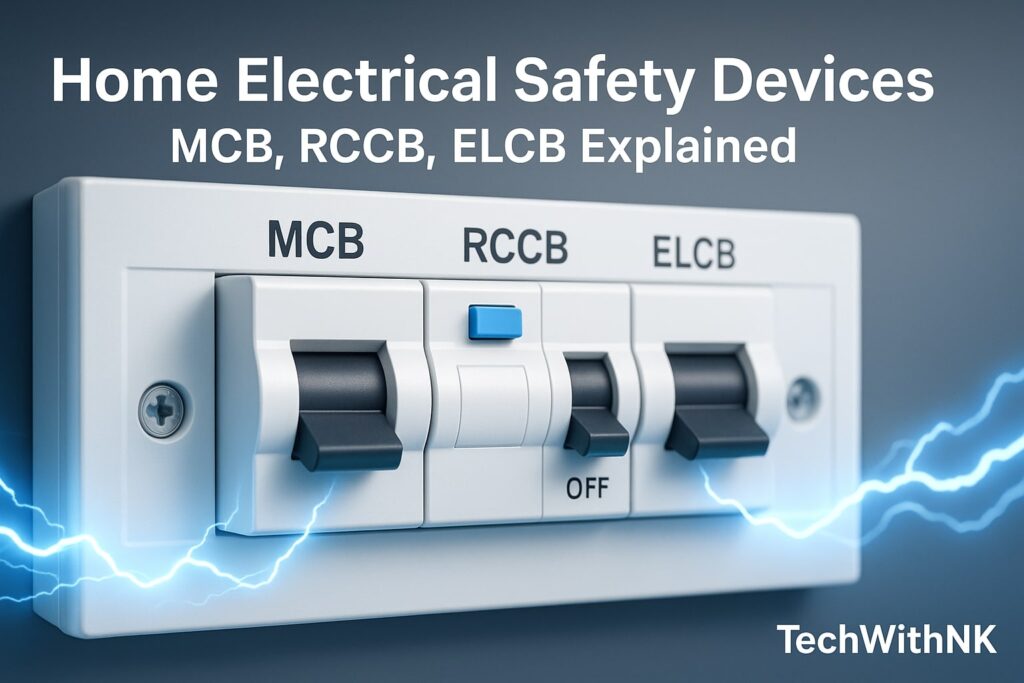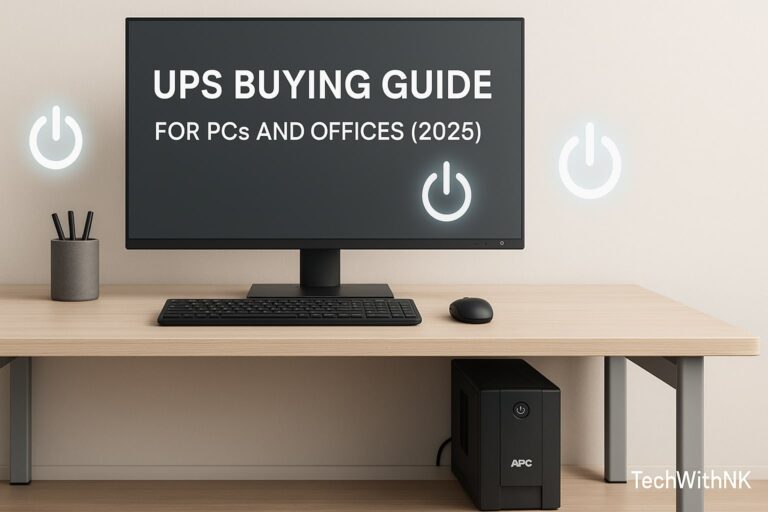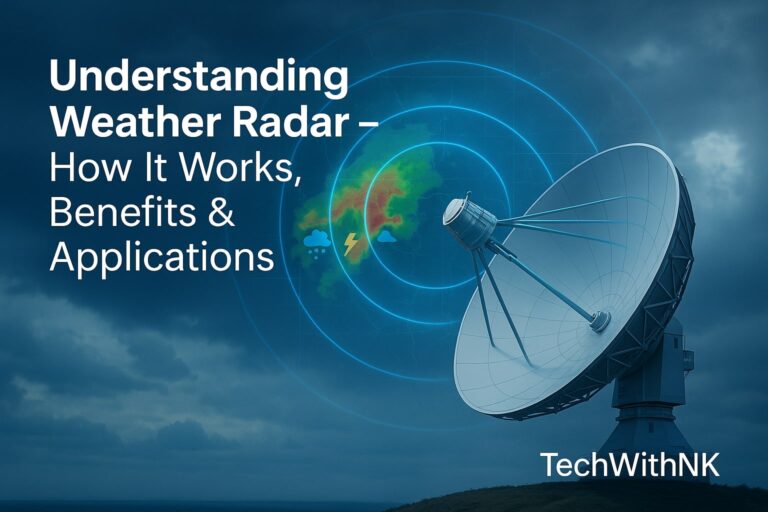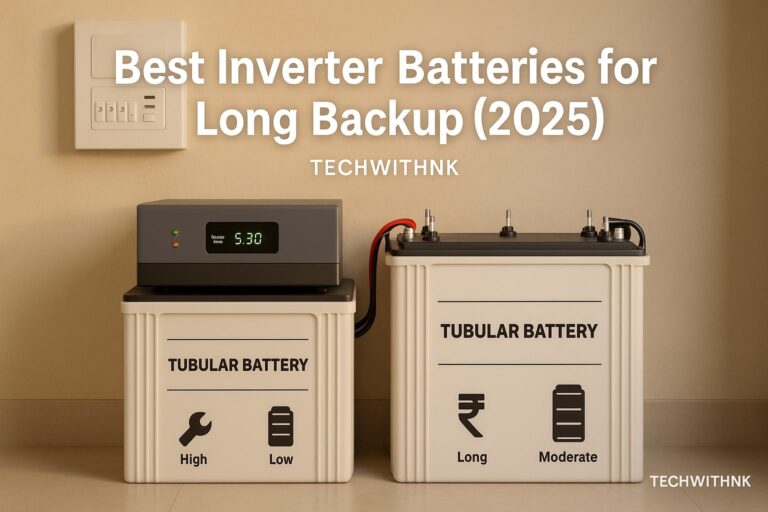🔌 Introduction
Electricity has become the backbone of modern homes — powering everything from lights and fans to smart TVs and refrigerators. However, with great convenience comes great responsibility. Electrical hazards such as short circuits, earth faults, and electric shocks can cause fires or fatal accidents if protective devices are not installed properly.
That’s where home electrical safety devices like MCB (Miniature Circuit Breaker), RCCB (Residual Current Circuit Breaker), and ELCB (Earth Leakage Circuit Breaker) come into play.
These are automatic protective devices designed to detect and isolate faulty electrical circuits before they cause harm to humans or property. In this detailed guide, we’ll explore how each of these devices works, their construction, ratings, applications, and how they differ from one another.
Why Electrical Safety Devices Are Essential
Electrical faults can occur anytime due to:
Overload (too many appliances on one circuit)
Short circuit (live wire touching neutral)
Earth leakage (current flowing to the ground)
Faulty wiring or damaged insulation
Without proper protection, these faults can lead to:
🔥 Electrical fires
⚡ Electric shocks
💀 Fatal accidents
💡 Damage to appliances and wiring
Hence, the primary role of safety devices is to sense abnormal current and automatically disconnect the circuit — protecting both life and property.
Understanding Basic Faults in Home Electrical Systems
| Type of Fault | Cause | Protection Device | Effect if Unprotected |
|---|---|---|---|
| Overload | Too many appliances drawing high current | MCB | Wire overheating, fire |
| Short Circuit | Phase and neutral contact | MCB | Fire, heavy damage |
| Earth Fault / Leakage | Current leaking to earth | RCCB/ELCB | Electric shock, fire |
| High Voltage Surge | Lightning or grid faults | SPD (Surge Protector) | Appliance failure |
Miniature Circuit Breaker (MCB)
🔍 What is an MCB?
An MCB is a switch that automatically turns off when current exceeds the rated limit. It replaces the older fuse wire and provides precise, resettable, and maintenance-free protection against overload and short-circuit faults.
🧠 Working Principle
An MCB works on two mechanisms:
Thermal Trip (Overload Protection):
A bimetallic strip bends when heated by excess current.
The bending triggers a latch to open the circuit.
The delay is proportional to current magnitude — small overload = slow trip, large overload = faster trip.
Magnetic Trip (Short-Circuit Protection):
A solenoid coil creates an electromagnetic field when a sudden high current flows.
It pulls a plunger instantly, opening the circuit in milliseconds.
⚙️ Construction
Housing: Fire-resistant plastic body
Toggle Switch: Manual ON/OFF operation
Contacts: Conducting parts for circuit connection
Bimetallic Strip: For thermal trip
Solenoid Coil: For magnetic trip
Arc Chute: Extinguishes arc during switching
Trip Mechanism: Releases contacts automatically
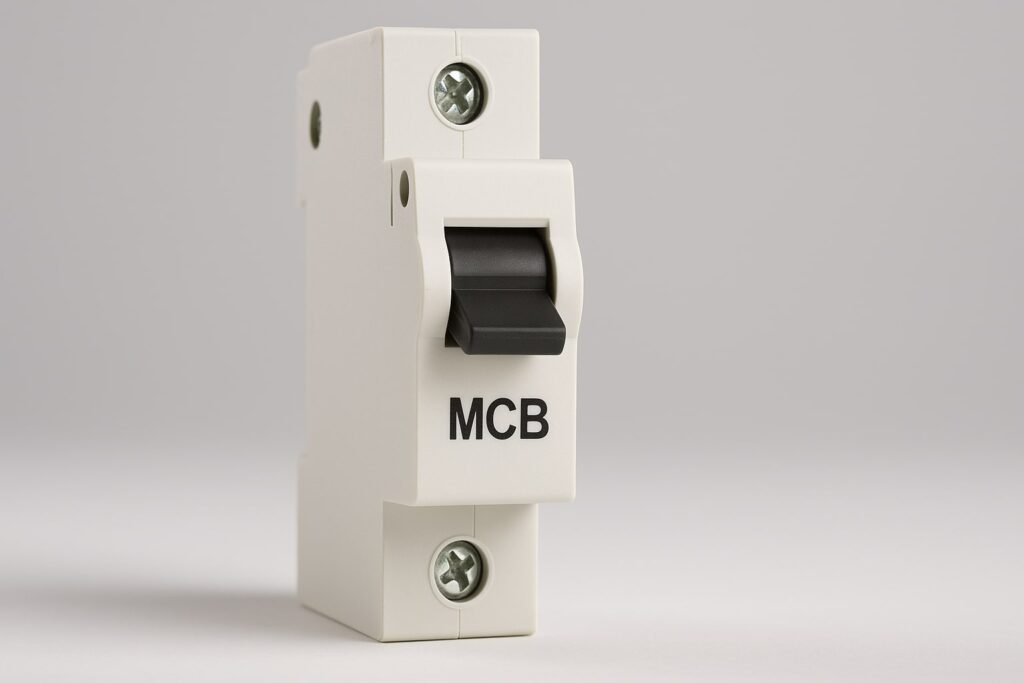
🔢 MCB Ratings
| Parameter | Range/Type |
|---|
| Current Rating | 6A, 10A, 16A, 20A, 25A, 32A, 40A, 63A |
| Voltage Rating | 230V (1P), 415V (3P) |
| Breaking Capacity | 6kA, 10kA |
| Tripping Curves | B, C, D Type |
⚡ Tripping Curves Explained
| Type | Trip Range | Application |
|---|---|---|
| B-Type | 3–5× rated current | Residential loads (fans, lights) |
| C-Type | 5–10× rated current | Motor loads, air conditioners |
| D-Type | 10–20× rated current | Industrial machines, transformers |
🏠 MCB in Home Applications
In a domestic distribution board (DB), MCBs are used for:
Individual room circuits
Geysers and heavy appliances
AC and kitchen loads
Each circuit has its dedicated MCB to isolate faults locally.
✅ Advantages of MCB
Resettable (no need to replace like fuse)
Faster fault isolation
Compact and safe design
Can be used as manual switch
Long lifespan
⚠️ Limitations
Cannot detect earth leakage
Slightly costlier than fuse
Needs correct curve selection
RCCB – Residual Current Circuit Breaker
🔍 What is an RCCB?
An RCCB (also called RCD – Residual Current Device) is designed to protect humans from electric shocks caused by earth leakage current.
It doesn’t react to overload or short circuit — it only detects difference in current between live (phase) and neutral conductors.
🧠 Working Principle
The device continuously compares the current in phase and neutral.
Under normal conditions:
Iphase=IneutralI_{phase} = I_{neutral}Iphase=IneutralWhen earth leakage occurs:
Iphase≠IneutralI_{phase} ≠ I_{neutral}Iphase=IneutralThis imbalance induces a current in the sensing coil inside the RCCB.
If imbalance exceeds the threshold (e.g., 30mA), the RCCB trips instantly (within 30 milliseconds).
⚙️ Construction
Toroidal Core Transformer (senses current difference)
Trip Coil (mechanical trip mechanism)
Test Button (T): Simulates leakage to test functionality
Reset Lever: To turn ON after trip
ON/OFF Indicator: Shows device status
🔢 RCCB Ratings
| Parameter | Values |
|---|---|
| Rated Current (In) | 25A, 40A, 63A, 80A, 100A |
| Sensitivity (ΔI) | 10mA, 30mA, 100mA, 300mA |
| Poles | 2P (Single Phase), 4P (Three Phase) |
| Voltage | 230V / 415V |
| Trip Time | ≤30 ms for 30mA |
⚡ Sensitivity Selection
| Leakage Sensitivity | Purpose |
|---|---|
| 10 mA | High sensitivity (wet areas, bathrooms) |
| 30 mA | Human safety (domestic circuits) |
| 100 mA | Equipment protection (small shops, offices) |
| 300 mA | Fire protection (main incomer) |
✅ Advantages of RCCB
Protects against electric shock
Detects earth leakage precisely
Automatic disconnection of faulty circuits
Improves electrical safety in homes
⚠️ Limitations
Cannot detect overload or short circuit
Must be used along with MCB
May trip due to nuisance leakage in old wiring
ELCB – Earth Leakage Circuit Breaker
🔍 What is an ELCB?
Before RCCB became standard, ELCBs were used to detect earth faults.
There are two types:
Voltage-operated ELCB (VO-ELCB)
Current-operated ELCB (CO-ELCB or RCCB)
The old voltage-operated type is now obsolete, but understanding it helps clarify how protection evolved.
🧠 Working Principle (Voltage-operated ELCB)
Connected between the metal body of an appliance and earth electrode.
When fault current flows through the body, a potential difference appears between body and earth.
If this voltage exceeds the threshold (typically 50V), the device trips.
⚙️ Limitations of Old ELCB
Could not detect faults if the earth connection broke.
Responded to voltage, not current imbalance.
Replaced by modern RCCB, which is more reliable.
⚙️ Modern ELCB = RCCB
Today, when people say “ELCB,” they often mean RCCB — the current-operated version used widely in homes.
Difference Between MCB, RCCB, and ELCB
| Feature | MCB | RCCB | ELCB (Old Type) |
|---|---|---|---|
| Protection Type | Overload & Short Circuit | Earth Leakage & Shock | Earth Voltage Leakage |
| Works on | Current magnitude | Current imbalance | Voltage difference |
| Detects Earth Fault | ❌ No | ✅ Yes | ✅ Yes |
| Detects Overload | ✅ Yes | ❌ No | ❌ No |
| Detects Short Circuit | ✅ Yes | ❌ No | ❌ No |
| Trip Time | ~2–100 ms | ≤30 ms | ~50 ms |
| Sensitivity | High (6A–63A) | 10–300mA | 30–100mA |
| Modern Usage | Mandatory in all circuits | Used with MCB | Obsolete |
Combination Devices – RCBO
An RCBO (Residual Current Breaker with Overload) combines the features of MCB + RCCB in a single compact unit.
It provides protection from:
Overload
Short circuit
Earth leakage
Ideal for individual circuits like geysers or ACs.
Wiring Layout in Home Distribution Board (DB)
A modern DB panel includes:
Main Isolator / MCB (Incomer)
RCCB (for human protection)
Individual MCBs (for each circuit)
Flow:
Meter → Main MCB → RCCB → Sub MCBs → Loads
Installation Tips and Safety Guidelines
Use ISI-marked devices from reputed brands (Legrand, Schneider, Havells, L&T, ABB).
Select correct ampere rating for MCB based on circuit load.
Ensure proper earthing (below 1Ω).
Use RCCB 30mA for all residential loads.
Test RCCB monthly using the TEST button.
Avoid overloading multiple appliances on single socket.
Real-Life Example: How They Work Together
Suppose your washing machine develops insulation leakage and current starts flowing to its metal body:
MCB: Won’t trip (no overload detected).
RCCB: Senses imbalance (phase ≠ neutral) and trips within milliseconds — saving you from electric shock.
ELCB: Would have tripped only if voltage rise between body and earth occurred.
Thus, RCCB offers superior life protection compared to MCB and old ELCB.
Testing and Maintenance
| Device | Test Method | Frequency |
|---|---|---|
| MCB | Simulate overload or press test switch (if available) | Yearly |
| RCCB | Press “TEST” button to verify trip | Monthly |
| ELCB | Test earth voltage rise | (Obsolete) |
Future of Home Safety – Smart Circuit Breakers
The next generation of protection devices are smart MCBs and RCCBs integrated with:
Wi-Fi connectivity
Real-time fault monitoring
Load analytics
Remote reset via mobile app
Brands like Schneider, ABB, and Hager are developing IoT-based energy management breakers — making homes not only safer but also smarter.
Summary Table
| Device | Protection Type | Typical Rating | Main Function |
|---|
| MCB | Overload, Short Circuit | 6A–63A | Prevent fire, cable protection |
| RCCB | Earth Leakage | 25A–100A / 30mA | Prevent electric shock |
| RCBO | Combined (MCB + RCCB) | 6A–40A / 30mA | Compact all-in-one protection |
| ELCB | Earth Voltage | 15A–60A | Outdated, replaced by RCCB |
Brands & Models Popular in India (2025)
| Brand | Popular Series | Unique Feature |
|---|---|---|
| Havells | DHRP MCB, DHM RCCB | Flame-retardant design |
| Schneider | Acti9 Series | Compact, smart features |
| Legrand | DX³ MCBs, RX³ RCCBs | High reliability |
| L&T | Tripper Series | Indian grid optimized |
| ABB | System pro M compact | Industrial-grade durability |
MCB protects equipment, RCCB protects humans.
Both must be installed together for full safety.
Always choose correct ampere and sensitivity ratings.
Periodic testing is mandatory.
Never bypass a tripped RCCB — find and fix the fault first.
